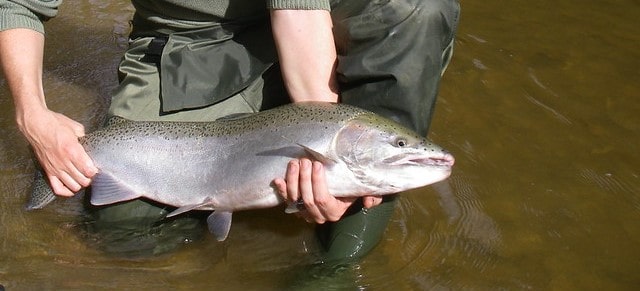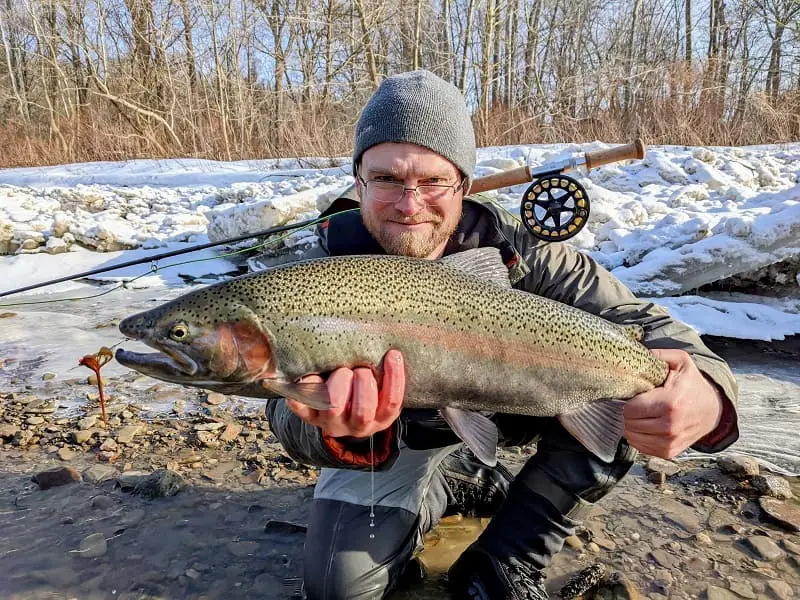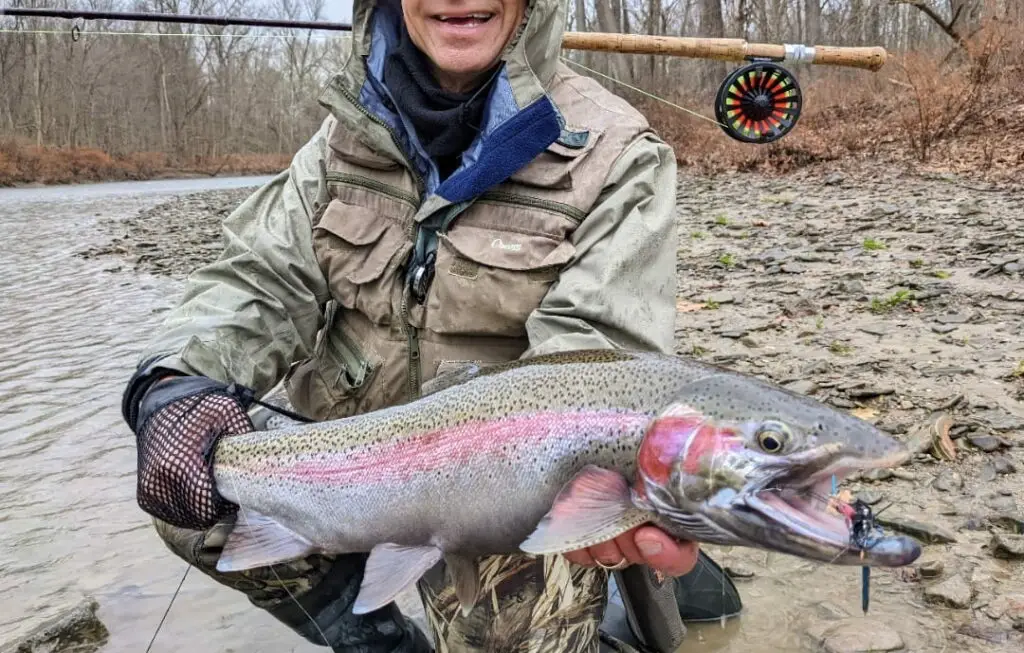Converting Finicky Steelhead On The Spey

Converting finicky steelhead on the Spey can be difficult for some anglers, but these tips from a Spey fishing guide can help you put more steelhead in the net. These are the tactics that guides use when their clients get a tap, but the steelhead won’t fully commit.
Converting finicky steelhead on the Spey is important for a guide because sometimes that will be the only fish of the day for their client. Converting finicky steelhead on the Spey is also something you can master with little effort.
The Take, The Grab, The Bite

I’ve now written a couple of Spey fishing articles on this website, for steelhead in fall and winter.
If you’ve read them, you know I include in both a section on how to react to a take.
Perhaps counterintuitively, my advice when a steelhead takes the fly is to freeze and do nothing at all until the fish has fully committed to the fly and you feel its entire weight on the line.
However, if you’ve been swinging flies any length of time, a potentially frustrating scenario has undoubtedly presented itself to you – you’ve had a take, but the moment of commitment never comes.
You’ve made a good cast, the fly has swung well and a fish has made itself known. Maybe it’s plucked or pulled at the fly as it swings. Perhaps you’ve felt it mouth the fly as it swims across the river in pursuit. It may even have chirped a turn or two of line from the reel.
But now the swing is over and you’re left standing with a quietly dangling fly-line and an inert reel, wondering where you went wrong and what to do next.
This article will attempt to answer those questions.
Why? Do They Just Miss It Or Is It Something Else?
While we can’t necessarily answer the question of why a steelhead would take the trouble to hunt a fly down and engage with it without bothering to eat it properly, we know from long experience and extensive literature that steelhead have commitment issues.
The writings of Roderick Haig-Brown from B.C. or Zane Grey from New Zealand detail maddening encounters where fish have returned repeatedly to flies, showing extreme interest but never really taking. Be in no doubt that this is standard operating procedure for steelhead.
Bad News!
Unfortunately, some fish can’t be caught.
However you approach this situation, you must acknowledge that you’ll have interactions with fish you never fool, and you’ll likely invest time and effort into enticing fish you never hook. This is the stark reality of steelhead Spey fishing.
In fall and winter, I’m able to hook approximately half the steelhead which engage with my flies without taking them. In spring, when the fish should theoretically be at their hungriest, my success rate drops to about 25%.
Much as I’d love to provide a sage and intelligent-sounding reason for this, I can’t come up with one. If you have any ideas, I’m all ears!
Good News!

If you’re new to Spey fishing for steelhead and you’ve experienced the tentative take of a capricious fish, take heart – you’re doing it right!
It’s abundantly clear to me that far from a discouraging sign of a flawed process, tentative engagements with steelhead are a sure sign that you’re in the zone.
Furthermore, a steelhead that’s shown a willingness to come to the fly once can often be tempted to do so repeatedly, and anglers have a great chance to hook these fish.
Below, I’ll discuss exactly how I go about converting faint takes into solid grabs and fish on.
Procedure
The first and most important step is: when you feel a fish, absolutely, positively DO NOT MOVE.
Whether or not the fish is one you can ultimately hook, a surefire way to destroy your opportunity to fool it is to move the fly before the fish has had a chance to properly eat it.
If you react to a tentative take by setting the hook or moving the fly in any way, the fish will not return and you can continue swinging through the run as though nothing had happened.
Second, get your bearings. I like to find a landmark on the nearside bank, so I know precisely where I was standing when the fish first took.
You’ll maintain the exact same cast length during the entirety of this procedure, so you’ll know exactly where your fly is in relation to the fish’s last known position.
Third, give the fish time to settle down. In order to poke your fly, the fish has had to leave its comfortable lie and move to intercept the fly as it swings.
Once it’s lost interest, it will circle back around and resume its initial position. You should delay your next cast for twenty or thirty seconds to allow for this.
Fourth, repeat the exact same cast which produced the contact with the fish. While I normally advocate moving quickly through the run, I suspend this practice when I’ve had a take.
There’s every chance a steelhead will take the fly solidly on the second opportunity if it has touched it once already.
Fifth, take several large steps back upstream before resuming casting.
There’s no guarantee the fish will assume the exact same position it had prior to the initial take. Retreating back upstream a few yards will ensure that you’ll have another opportunity to present the fly to it if it’s relocated slightly further upstream than before.
Finally, resume casting and stepping through the run as before, but at a slower pace than normal.
If you would typically take three or four large steps between casts, reduce it to one or two small steps. The goal should be to dissect the area where you know the fish to be and present the fly at all possible angles. Pay particular attention to the area around the landmark you identified when you first felt the fish.
If this procedure doesn’t result in a solid take, the angler should definitely make another pass through the run with a different fly.
Fly Size and Color
One thing I do when Steelhead is being picky or after I get a grab is I will immediately change the fly color or fly size.
Sometimes I will do both.
If a fish grabs a two-inch black Spey fly, I will often go totally opposite and try a white or bright color streamer of the same size or bigger. Sometimes I will keep the color the same but will upsize the fly by two or three inches, or if I am already using a very large fly, I will downsize by two or three inches.
I have converted many grabbers into hookups with a quick change of color or size.
Gareth
